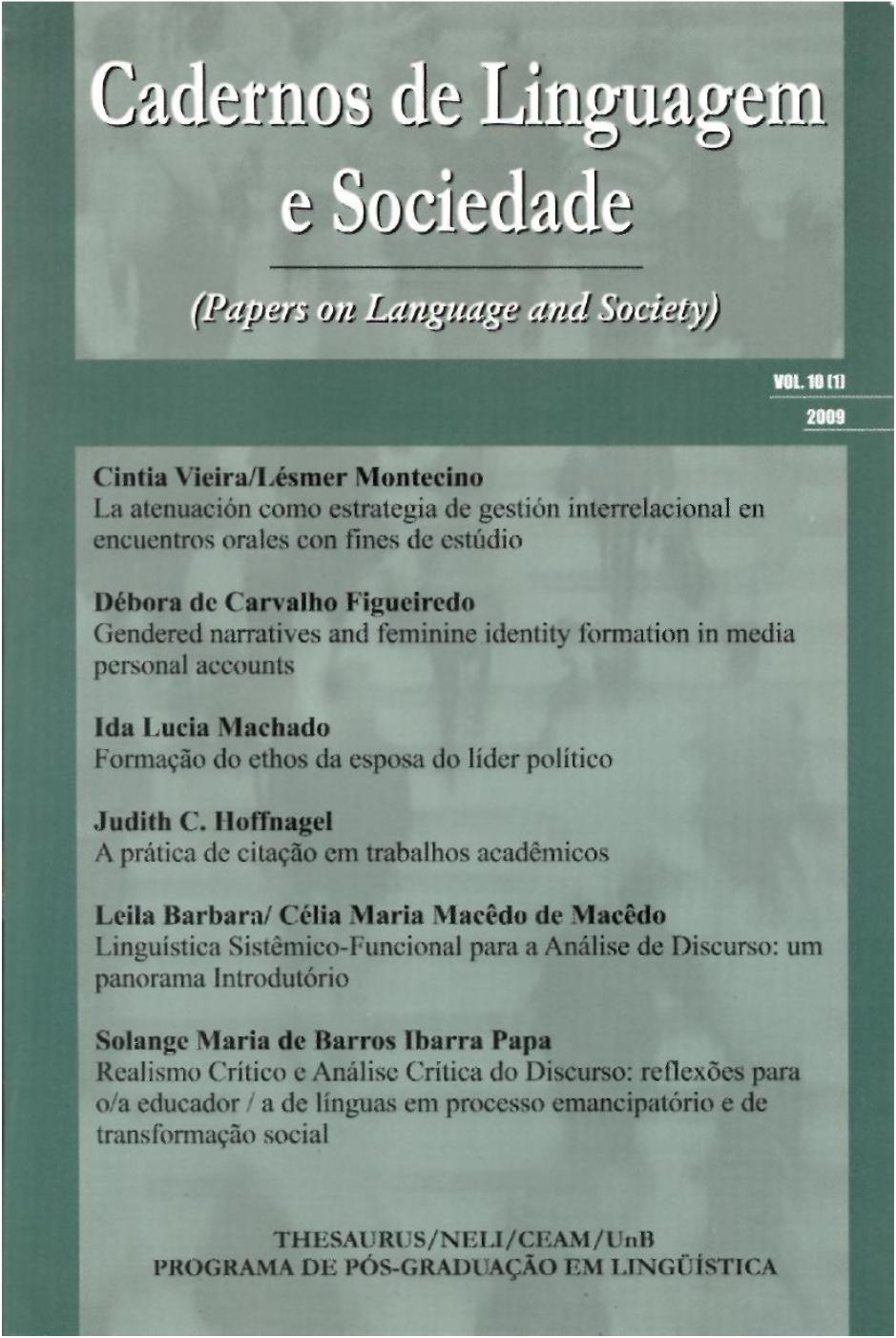Gendered Narratives And Feminine Identity Formation In Media Personal Accounts
DOI:
https://doi.org/10.26512/les.v10i1.9275Keywords:
Feminine identity formation. Narrative studies. Critical discourse analysisAbstract
In late modernity, the concepts of identity and identity formation have become inseparable from language and discourse. In this article, based on the theoretical frameworks of Critical Discourse Analysis (CDA), Identity Studies, Narrative Studies and Genre Studies, I investigate how the identities of three women, especially in what concerns their body design, is construed in the genre ‘media personal accounts’, in the present case accounts of experiences of cosmetic plastic surgery published in two Brazilian glossy magazines, Claudia and Plastic Surgery&Beauty (Plástica&Beleza).
Downloads
References
Bamberg, M. G. W. (Ed.). (1997). Oral versions of personal experience: Three decades of narrative analysis. Journal of Narrative and Life History. 7 (1-4) ”“ Special Issue.
Bonini, A. (2001). Ensino de gêneros textuais: A questão das escolhas teórica e metodológica. Trabalhos em Lingüística Aplicada. 37, 7-23.
Bruner, J. (2004). Life as narrative. Social Research, 71(3).
Bruner, J. (1990). Acts of meaning. Cambridge, MA: Harvard University Press.
Caldas-Coulthard, C.R. (1996). ‘Women who pay for sex. And enjoy it’. Transgression versus morality in women’s magazines. In C.R Caldas-Coulthard & M.Coulthard (Eds.), Texts and practices: Readings in critical discourse analysis. London: Routledge.
Duranti, A. (1986). The audience as co-author: An introduction. Text, 6, 239-47.
Fabrício, B. F. (2006). Narrativização da experiência: o triunfo da ordem sobre o acaso. In I. Magalhães, M. J. Coracini & M. Grigoletto (Eds.), Práticas Identitárias: Língua e Discurso. São Carlos: Claraluz. Fairclough, N. (1992). Discourse and Social Change. Cambridge: Polity Press.
Fairclough, N. (2003). Analysing discourse: textual analysis for social research. London: Routlege.
Fairclough, N. (2006). Language and globalization. London: Routledge.
Figueiredo, D.C. (forthcoming) Identidades corporificadas nos discursos midiáticos pós-modernos: os discursos sobre o emagrecimento e a cirurgia plástica. Anais do 7o. Encontro do CELSUL (Círculo de Estudos Lingüísticos do Sul).
Habermas, J. (1984). Theory of communicative action, Vol. 1, London: Heinemann.
Hall, S. (1996). Who needs identity? In S. Hall, & P. Du Gay (Eds.), Questions of identity. London: Sage.
Halliday, M.A.K. An introduction to functional grammar. 3. ed. London: Edward Arnold, 2004.
Hoey, M. P. (1979). Signalling in discourse. Discourse Analysis Monographs, 6, English Language Research, University of Birmingham.
Hoey, M. P. (1983). On the surface of discourse. London: Allen & Unwin.
Labov, W. (1972). Language in the inner city. University Park, PA: University of Pennsylvania Press.
Labov, W & Waletsky, J. (1967). Narrative analysis: Oral versions of personal experience. In J. Helm (Ed.), Essays on the verbal and visual arts. Seattle, WA: University of Washington Press.
Meurer, J. L. (2002). Reflexões sobre o ensino: Três perguntas não mistificadoras que você pode aplicar aos textos que traz para a sala de aula. In M.J.D Costa; M.E. Zipser, M.E.; Zanatta, M.& A. Mendes, A. (Orgs.). Línguas: ensino e ações. Florianópolis: Editora da UFSC.
Mishler, E. (1999). Storylines: Craftartists’ narratives of identity. Cambridge: Harvard University Press.
Moita Lopes, L. P. (2001). Práticas narrativas como espaço de construção das identidades sociais: uma abordagem socioconstrucionista. In B. T. Ribeiro, C. C. Lima & M. T. L. Dantas (Eds.), Narrativa, Identidade e Clínica. Rio de Janeiro: Edições IPUB-CUCA.
Moita Lopes, L.P. (1999) Perceptions of language in L1 and L2 teacherpupil interaction: the construction of readers’ social identities. In C. Schaffner & A. Wenden (Eds), Language and peace. Amsterdam: Harwood Academic Publishers.
Moita Lopes, L.P. (1998) Discursos de identidade em sala de aula de leitura de L1: a construção da diferença. In I. Signorini (Org.), Lingua(gem) e identidade. Campinas: Mercado de Letras.
Norrick, N. R. (1997). Twice-told tales: Collaborative narration of familiar stories. Language in society, 26(2), 199-220.
Paltridge, B. (1996). Genre, text type, and all the language learning classroom. ELT Journal, 50(3), 237-243.
Schiffrin, D. (1996). Narrative as self-portrait: sociolinguistic constructions of identity. Language and Society Processes, 25(2), 167-203.
Schiffrin, D. (1984). How a story says what it means and does. Text, 4(4), 313-346.
Segal, J. (2007). Breast Cancer Narratives as Public Rhetoric: Genre Itself and the Maintenance of Ignorance. Linguistics and the Human Sciences. Special issue on Genres and Social Ways of Being, Vol 3, No 1.
Sousa (2003). Resistir, a que será que se resiste? O sujeito fora de si. Linguagem em Discurso, 3, special issue, 37-54.
Swales, J. M. (1990). Genre analysis: English in academic and research settings. Cambridge: Cambridge UP.
Van Leeuwen, T. (1996). The representation of social actors. In C.R Caldas-Coulthard & M. Coulthard (Eds.), Texts and practices: Readings in critical discourse analysis. London: Routledge.
Woodward, K. (1997). Introduction. In K. Woodward (Ed.), Identity and difference. London, Sage.



